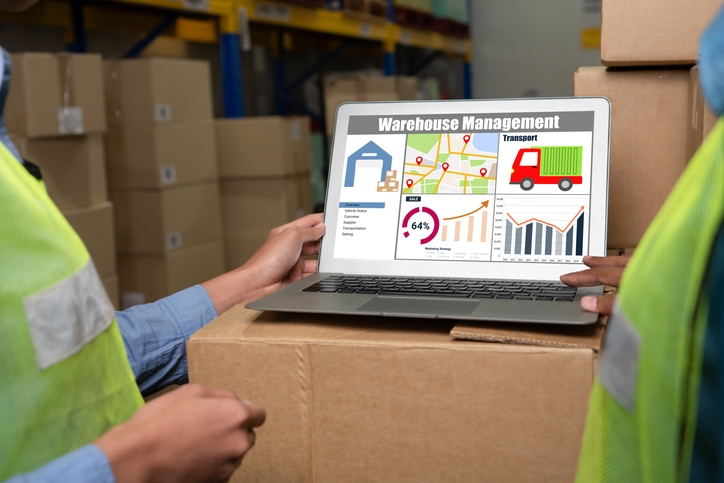
Accuracy and efficiency are paramount in the ever-changing freight forwarding sector. You need to get freight forwarding software to make it big in this cutthroat industry. If you're in the market for new freight forwarding software, this article will walk you through all the important features to look for. Furthermore, we will explore the remarkable features of Logi-Sys, a prominent solution in the field.
This article will discuss the most important criteria a company should use to select freight forwarding software. We have also reviewed in detail how Logi-Sys meets all the requirements. Logi-Sys is an all-inclusive programme for managing freight and logistics.
What Exactly Is Freight Forwarding Software?
Regarding keeping tabs on incoming and leaving cargo, logistics operations specialists and freight forwarders rely on freight forwarding software. Freight forwarding software lets you digitally track information and discuss it with necessary parties, eliminating the need to do everything by hand. The ultimate goal of freight forwarding software is to streamline your team's delivery processes and make everyone's lives easier.
Additionally, freight forwarding software lessens or even eliminates the possibility of human mistakes. This programme keeps your team apprised of the precise location of each item in transit by tracking shipments down to the stock-keeping unit (SKU) level. You may use this information to enhance your communication with clients, make more accurate delivery estimates, and cultivate relationships with them along their journey.
The Development Of Software For Freight Forwarding
The History Of Development Of Freight Forwarding Software
Recent innovations in freight forwarding software are indicative of the increasing complexity of global trade and the resulting need for better logistical solutions. Freight forwarding was a very labour-intensive procedure that required a lot of physical coordination, phone calls, and documentation. This analogue method had its uses but needed to be faster and prone to mistakes.
When computers were originally introduced in the middle of the twentieth century, they were a huge leap forward in the automation of logistics. The first freight forwarding software programs appeared to manage the most fundamental functions, such as paperwork and record keeping. However, the complexity and interconnection needed for contemporary international trade were absent from these earlier systems.
The software used for freight forwarding evolved throughout the years in tandem with technological developments. As the internet and other kinds of digital communication proliferated towards the century's conclusion, cloud computing became a reality. These tools made it possible to automate document management, track in real-time, and streamline communication with stakeholders.
The Way Technology Has Changed The Logistics Sector
Digital freight forwarders are changing the game in the logistics industry, which is changing fast. The importance of openness and efficiency in supply networks grows as international trade becomes more interconnected.
As a result, new types of businesses have emerged: digital forwarders, whose mission is to improve business processes through the strategic use of technology. Forwarders in the digital space use technology to:
Enhance the Client Experience: Forwarders can offer clients up-to-date information through real-time tracking, precise pricing, and streamlined reservations, ultimately leading to better decision-making.
Increased Productivity: By streamlining operations and eliminating human labour, digitisation improves efficiency, reducing costs and shortening turnaround times.
Acquire insights driven by data: Forwarders can utilise real-time data for predictive analytics to learn about cargo patterns, transit times, and possible bottlenecks.
Promote Cooperative Innovation: Forwarders and carriers can collaborate on technical advancements like blockchain applications for a more secure and transparent supply chain.
Different Software Types For Freight Forwarding Management
Although there is a wide variety of freight forwarding management software, each is tailored to address certain difficulties. The extraordinary adaptability of these gadgets will astound you.
Transportation Management Systems (TMS)
Transportation management systems aim to streamline and improve the shipping process from start to finish. Everything from freight audits and payments to route planning and carrier selection is a breeze with TMS.
Warehouse Management Systems (WMS)
Warehouse operations, including inventory management, pick-and-pack services, and product storage, are the primary emphasis here. You can greatly enhance your warehousing efficiency with a quality WMS.
Supply Chain Management Software (SCMS)
A supply chain management system (SCMS) aims to coordinate and improve all aspects of the supply chain. Supply chain management is an all-encompassing term that covers the whole process, from raw material procurement and production to shipping and delivery. We also have advanced software for managing your supply chain if that's what you're after.
Enterprise Resource Planning Systems (ERP)
Enterprise resource planning (ERP) systems integrate a company's purchasing, operations, distribution, and logistics processes, among many others. All of your operational data is saved in one single area with an ERP system, making it easy to access and evaluate throughout your whole firm.
Customer Relationship Management Systems (CRM)
While customer relationship management systems aren't just used in logistics, they are crucial for freight forwarding companies to manage customer interactions better and provide better customer care. They let businesses keep tabs on and organise customer data, including interactions, preferences, and comments.
You have a wide variety of alternatives to choose from. Remember that your company's unique requirements and operational intricacies largely dictate the freight forwarding management software you use.

Basic Features Of Software For Freight Forwarding Management
The best freight software should streamline your processes and be a one-stop shop. All under one roof: document management, communication facilitation, job maintenance, customer and supplier connection establishment, financial oversight, report generation, and more. The following platform features are reliable:
Centralised Dashboard: A straightforward interface that gives a bird's-eye perspective of all current processes; users may check on shipments, keep tabs on inventory, handle money, and get important documents.
Shipment Management: Makes it easier to plan, execute, and track shipments by providing real-time information, optimising routes, and managing various transportation modes (air, sea, rail, and road).
Documentation And Compliance: Facilitates adherence to customs and international trade regulations by centralising the generation and administration of vital shipping papers such as packing lists, bills of lading, and commercial invoicing.
Inventory Management: Helps with inventory asset management, stock rotation, and order fulfilment by showing where things are stored and how much is in stock at the warehouse.
Financial Management: Unifies all accounting processes, such as billing, payments, and spending. Accurate financial reporting and analysis are provided, and it helps with budgeting and controlling costs.
Customer Relationship Management (CRM): Improvements in customer service are achieved by carefully managing client information, preserving past encounters, and promoting collaboration between departments.
Integration And API: Guarantees error-free communication with third-party applications and services, including enterprise resource planning (ERP), transportation management system (TMS) systems, and various carrier platforms.
How Software For Freight Forwarding Management Operates
Shipment information (origin, destination, product specifications, and mode of transit) is first entered by users. The programme communicates with customs, transporters, and other entities to keep the data up-to-date and accurate. After that, the programme figures out the best shipping routes by considering restrictions, costs, and travel times. It then coordinates with shipping companies and others to get the packages moving.
Users can address any problems as they arise because the program constantly notifies them of the shipment's status. You may comply with international regulations with the software's automated document-generating and submission features. The software helps with budgeting and expense control, collecting data, creating invoices, and generating reports.
Last but not least, the software streamlines customer service and encourages repeat business by keeping tabs on interactions and facilitating teamwork.
Why Freight Forwarding Software Is Necessary
The supply chain relies on freight forwarders, who operate as middlemen between producers and shipping destinations, to stay up with the fast-paced market growth. This requires extremely efficient software.
Efficiently navigating international trade is the main focus of freight forwarding. With the assistance of freight forwarding, shipments become dependable, fast, and targeted. Many multinational corporations depend on it because of that. Updating software regularly improves customer-attracting and -retaining workflows.
Increased Authority Over The Shipment
Freight forwarding software allows shipping-centric businesses greater say over operational efficiency. Everything from shipments to estimates and billing can be managed in one streamlined system. That improves the rate of on-time delivery and helps to be ready for problems or delays in shipping.
Workflows That Are Well-Organised And Productive
Every business has a unique workflow to provide the greatest service to their employees and clients. Software for freight forwarding improves these processes by illuminating critical phases. Additionally, it reveals potential bottlenecks that are causing delays. These tools aid logistics, paperwork, shipments, correspondence, and container tracking.
Enhanced Financial Control
Every number counts When dealing with a rapidly expanding market like freight forwarding. Invoicing customers, managing credit, approving transportation costs, and tracking sales commissions are all handled by dedicated software. With improved precision about cash flow, businesses can set up a robust operational profitability study.
Which Are The Most Vital Considerations When Choosing A Freight Forwarding Software?
Finding out how to begin evaluating freight forwarding software is a common question. Get the most out of your business and operations with this concise checklist of must-have criteria.
Intuitive Interface For Users
For employees who must use it, how user-friendly is the programme? Enquire about the ease of use on various devices and browsers. Employees may require mobile device access to the system. You will also consider the user interface and how consumers manage their shipments with the system.
Cloud-Based Software
Look at cloud-based software solutions that provide safe shipping and container tracking, remote access, and more. This way, you can rest easy knowing that data is accessible for domestic and international freight forwarding on an unlimited number of devices, with the possibility to restore data in an emergency.
Documentation
Recognising where processes must change to reduce mistakes is essential for expanding operations. You can observe what needs doing in your freight forwarding software in terms of reporting capabilities, which will help you build your business and stay ahead of problems before they affect shipment efficiency.
The Ability To Scale
Your freight forwarding software should be scalable, meaning it can handle not just your firm's current demands but also your expansion plans for the next five years. Information security, massive shipping tracking, and reports that can handle an expanding clientele are all aspects of scalability.
Client Support
Consider the provider's customer service record before buying freight forwarding software. Get to know the people who will help you integrate, onboard your team to the system, and troubleshoot when problems arise. If you need help fixing an issue quickly so your company can keep working well, look for a company with a good ticket management system.
Values Of Vendors
Looking at your vendor's values is the last but certainly not least step. You must consider the decision's lifespan and how to make a great pick by considering whether the company views you as a relationship that can grow with your freight forwarding business as you incorporate the software or as just another customer.
Freight Forwarding Software Implementation Challenges
Despite the many potential advantages, there are certain obstacles to overcome when implementing freight forwarding software. Among the most typical challenges are:
Integration Difficulty: Integrating the software with current systems and procedures may take a lot of effort and time. Careful preparation and execution are necessary in case compatibility concerns emerge.
Information Security: Strong security measures must be implemented while dealing with sensitive shipping and customer data to prevent data breaches and cyberattacks.
Learning And Understanding: Making sure the software is widely used throughout the company and training staff to utilise it successfully are difficult tasks. It is necessary to manage resistance to change because it is common.
Start-Up Investment: Depending on the programme you go with, the initial expenditure on software deployment can be rather high. It could be difficult for smaller logistics companies to afford more sophisticated systems.
Logistics, as a comprehensive freight forwarding software, offers solutions to these common challenges in the following ways:
Simplifying Integration: Logistaas provides an intuitive interface that integrates easily with preexisting systems and emphasises integration. Thanks to its modular design, you may reduce complexity and minimise disturbance to ongoing operations by choosing individual capabilities to integrate progressively.
Strong Data Security: Data security is a top priority for logistics companies, and Logistaas gets that. The programme is equipped with state-of-the-art security protections to protect important shipping and customer data. These methods include encryption, access controls, and frequent security updates.
User-Compatible Design: Logistaas focuses on making things easy for users. Employees will have a shorter learning curve because of its user-friendly design and straightforward navigation. Assistance and training materials are easily accessible to guarantee a seamless transition.
Manageable Costs: Logistaas has various pricing options, with a low beginning price per user monthly. Because of its scalability, logistics organisations of all sizes may access cutting-edge solutions that work for them.
Committed Client Assistance: To help with the installation and continuous use of their software, Logistics offers specialised customer support and training resources. To ensure users have a good experience, their crew is ready to answer any queries or handle any problems.
Frequently Asked Questions
What Is Freight Forwarding Software, And How Does It Work?
Freight forwarding software is a digital solution that streamlines and automates freight forwarders' and shippers' logistics and supply chain management processes. It helps manage tasks such as booking shipments, tracking cargo, and handling documentation efficiently.
Why Is Freight Forwarding Software Important For Businesses In The Logistics Industry?
Freight forwarding software is crucial because it enhances operational efficiency, reduces manual errors, improves shipment visibility, and improves stakeholder communication. It ultimately helps businesses save time and money while providing better customer service.
What Are The Key Features Of Freight Forwarding Software Should Businesses Look For?
Important features include shipment tracking, document management, rate management, inventory control, customs compliance tools, and integration capabilities with other systems, like accounting and CRM software. These features streamline processes and increase productivity.
Can Small Businesses Benefit From Freight Forwarding Software, Or Is It Mainly For Larger Companies?
Freight forwarding software is beneficial for businesses of all sizes. While larger companies may have more complex logistics needs, small businesses can still benefit from the automation, accuracy, and cost savings of software solutions.
Are There Any Security Concerns Associated With Using Freight Forwarding Software For Sensitive Data And Information?
Security is a top priority for most freight-forwarding software providers. Look for software solutions that offer robust encryption, data access controls, and compliance with industry regulations to ensure the security of your sensitive data and information.

